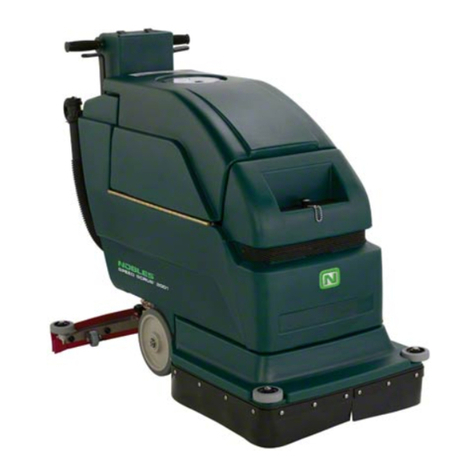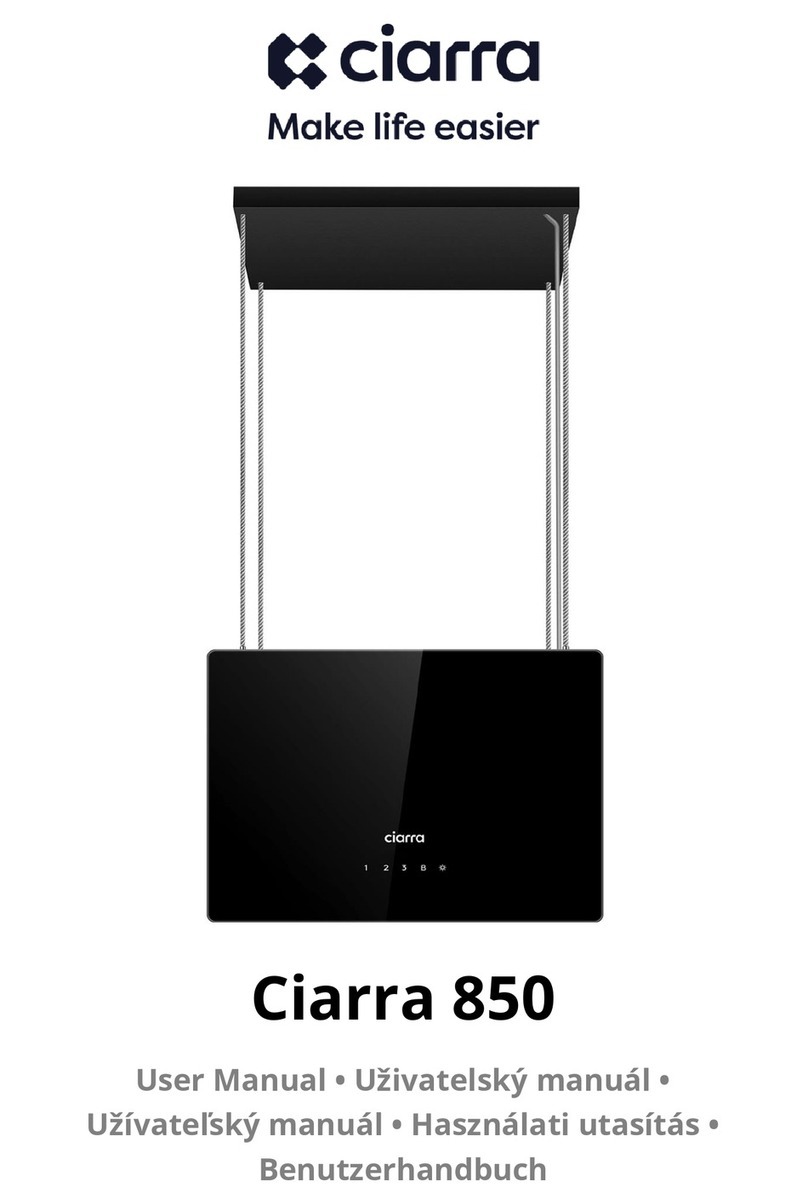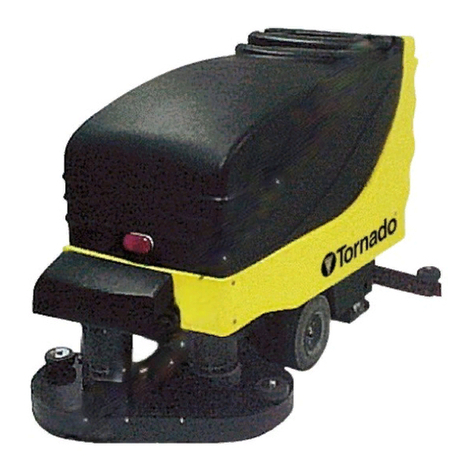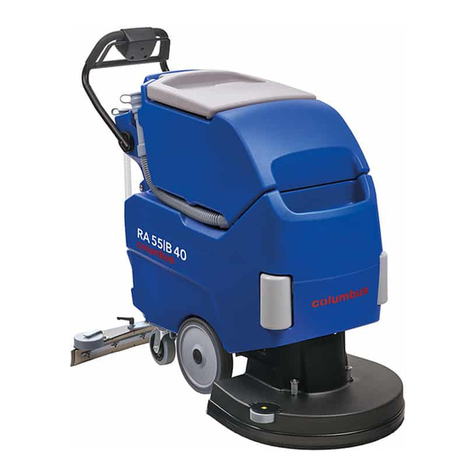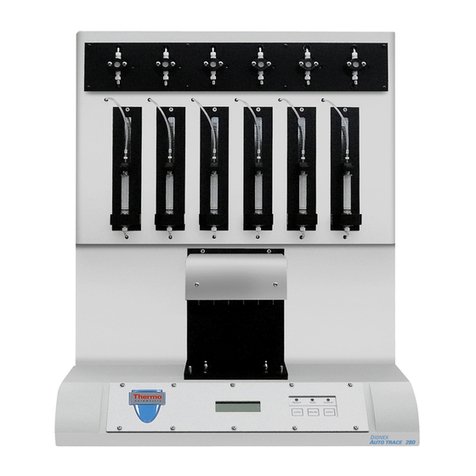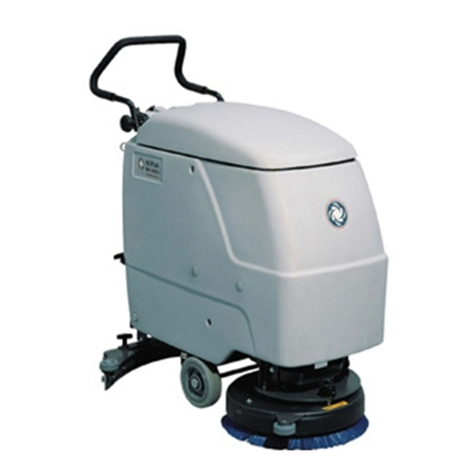Hillyard TRIDENT T20SC PRO User manual

SERVICE MANUAL
TRIDENT T20SC PRO
Version: AB
Date: November 7, 2018
Document Number:10077483

Contents
I Product Introduction 3
1 Serial Number and Technical Support 4
1.1 The Serial Tag ................................. 4
1.2 Serial Tag location ............................... 4
2 Main Technical Features 5
II Anomalies Resolution Guide 7
3 Trouble-shooting for the most common anomalies 8
3.1 Electrical system: what to do if. . . ...................... 8
3.2 Mechanical scrubbing system: what to do if. . . .............. 11
3.3 Drying system: what to do if. . . ....................... 12
3.4 Frame and traction system: what to do if. . . ................ 14
3.5 Solution delivery system: what to do if. . . ................. 15
3.6 Alarm Table ................................... 16
4 Disassembling Procedures 18
4.1 Electrical Installation ............................. 19
4.2 Mechanical Friction System ......................... 20
4.3 Drying System ................................. 22
4.4 Frame and Traction System ......................... 24
4.5 Solution Delivery System ........................... 25
III Machine Description 27
5 Electrical System 28
5.1 Structure T20SC PRO ............................. 28
5.2 Description T20SC PRO ............................ 28
5.3 Location of Electrical components ...................... 29
5.4 Adjustments .................................. 35
5.5 Maintenance and Checks ........................... 37
5.6 Programming .................................. 38
5.7 Menu Tables .................................. 41
2

6 Mechanical Rubbing System 47
6.1 Description ................................... 47
6.2 Adjustments .................................. 49
6.3 Maintenance and checks ........................... 50
7 Drying System 52
7.1 Structure .................................... 52
7.2 Description ................................... 52
7.3 Adjustments .................................. 53
7.4 Maintenance and Checks ........................... 53
8 Machine Frame and Traction System 56
8.1 Structure .................................... 56
8.2 Description ................................... 56
8.3 Maintenance and Checks ........................... 57
9 Cleaning Solution Supply System 58
9.1 Structure .................................... 58
9.2 Description ................................... 58
9.3 Maintenance and Checks ........................... 59
10 Consumable & Recommended Spare Parts 60
10.1Consumable Spare Parts ........................... 60
10.2Recommended Spare Parts .......................... 62
3

Part I
Product Introduction
4

Chapter 1
Serial Number and Technical Support
1.1 The Serial Tag
1.2 Serial Tag location
To have access to the Serial Tag is necessary to lift the recovery tank.
The Serial Number is an extremely important information which has to be provided
each time a Technical Support is required or is necessary to buy spare parts or
accessories. The serial number is the only way to identify the machine by model,
production date type equipments in general.
5

Chapter 2
Main Technical Features
Technical Data
TECHNICAL DESCRIPTION U/M T20SC PRO
Traction Motor (Voltage - Nominal Power) V-W 24-180
Ramp Gradient in transport1% 10
Max speed in transport (Default) mph 2.2
Supply/Traction V 24-Aut.
Vacuum Motor (Voltage - Nominal Power) V-W 24-420
Vacuum motor Stages Nr 2
Vacuum group suction mbar 91,4
Steering diameter in 77
Suggested battery (Voltage - Power) V-AhC5 12 - 110
Maximum batteries weight lb 180
Battery compartment dimensions
(Width-Length-Height)
in 19-14-10
Solution Tank gal 16
Recovery Tank gal 17
Usage temperature (Min - Max) °F 32-110
Sound pressure level (ISO 11201) LpA dB (A) ≤70
Hand vibration level (ISO 5349) ft
s2≤3,60
1Machine + batteries + full solution tank
6

Technical Data T20SC PRO
TECHNICAL DESCRIPTION U/M Disc Orbital
Working width in 20 20
Working capacity, up to f t2
h19200 19200
Total Power W 1090 1150
Brushdeck Motor
(Number - Voltage - Nominal Power)
Nr-V-W 1-24-500 1-24-560
Disc Brushes (Number - External Ø) Nr-Øin 1-20 -
Brushes revolutions rpm 140 -
Rectangular Pad
(Number - Width - Length)
Nr-in-in - 1-20-14
Oscillations per minute Nr - 2400
Max Weigth on brush lb 106 110
Machine Length in 51 48
Machine Height in 43 43
Machine Width (without squeegee) in 21 20
Machine Width (with squeegee) in 28 28
Weights and Pressures T20SC PRO2
TECHNICAL DESCRIPTION U/M Disc Orbital
Machine Weight (empty and without batteries) lb 152 167
Machine Gross Weight, work condition
(machine + batteries + water)
lb 360 375
Weight on front right wheel lb 114 ÷163
Pressure made by the front right wheel lb
in282 ÷111
Weight on front left wheel lb 101 ÷153
Pressure made by the front left wheel lb
in277 ÷121
Weight on rear right wheel lb 23 ÷98
Pressure made by the rear right wheel lb
in2234 ÷734
Weight on rear left wheel lb 23 ÷98
Pressure made by the rear left wheel lb
in2234 ÷734
2Weight and Pressures depends on how much water there is in the tanks and on what type of battery the
machine fits.
7

Part II
Anomalies Resolution Guide
8

Chapter 3
Trouble-shooting for the most common
anomalies
3.1 Electrical system: what to do if. . .
The machine doesn’t switch on
1. The key is in position 0 ⇒Rotate the key in position I.
2. The key microswitch is not properly
connected ⇒Restore the proper connections.
3. The key microswitch doesn’t work ⇒Replace the key microswitch (see section
4.1.1 at page 19).
4. The batteries don’t work properly ⇒Refer to the proper section (see section
3.1 at page 9).
9

The batteries don’t work properly
1. The batteries are not properly con-
nected ⇒Connect properly the loop cable and
the power supply cables.
2. Battery are discharged ⇒Perform a complete charge cycle.
3. Battery terminal are oxidized ⇒Disconnect the batteries, clean the
batteries terminals and reconnect
properly the batteries.
4. With the machine in working con-
ditions one battery has a voltage
lower (difference higher than 2 V)
than the other ones
⇒Replace the battery with lower volt-
age.
5. The fuse on the loop wire is dam-
aged ⇒Check for possible short circuits, If
not present replace the loop wire.
6. The power wires are damaged ⇒Replace the damaged wires.
7. The battery charger is not properly
adjusted ⇒Adjust properly the battery charger
(see section 5.4.1 at page 35).
8. The battery charger doesn’t work ⇒Check the proper section (see section 3.1
at page 9).
The battery charger doesn’t work
1. The battery charger is not con-
nected to the power supply ⇒Connect the charger to a supplied
electric socket.
2. The battery charger is not con-
nected to the batteries ⇒Connect the charger to the batteries.
3. The battery charger has one or
more lights (or LEDs) blinking con-
tinuously
⇒The battery charger is in error con-
ditions, verify the alarm tables and
solve the issue by following the re-
lated instructions (see section 5.4.1 at page
35).
4. The battery charger is properly con-
nected but it doesn’t switch on ⇒Replace the battery charger.
10

The display shows an alarm message
1. The display shows an alarm mes-
sage ⇒Check what alarm message is
shown and solve the related issue
by following the proper instructions
(see section 3.6 at page 16).
The machine has a very limited working autonomy
1. The batteries connections are oxi-
dized ⇒Unplug the connection wires, wash
the wire connections with water and
reconnect them protecting them with
grease.
2. When the machine is working a bat-
tery voltage is lower and lower than
the other batteries (The difference is
bigger than 2V)
⇒Replace the battery with the lower
voltage.
3. The battery charger is not properly
adjusted ⇒Verify the type of battery in use and
adjust the battery charger properly
following the instructions (see section
5.4.1 at page 35).
4. The BDI (Battery Discharge Indica-
tor) is not properly adjusted ⇒Verify the type of battery used on
the machine and adjust properly the
BDI (see section 5.7.1 at page 41).
5. Batteries have been working for
several cycles ⇒Replace the batteries.
11

3.2 Mechanical scrubbing system: what to do if. . .
The machine doesn’t clean well
1. The machine is switched off ⇒Switch on the machine.
2. The machine doesn’t switch on ⇒Refer to the proper section (see section
3.1 at page 8).
3. The display shows an alarm mes-
sage ⇒Check what alarm message is
shown and solve the related issue
by following the proper instructions
(see section 3.6 at page 16).
4. The ”ECO” switch is not pressed ⇒Press the ”ECO” switch.
5. The safety switch doesn’t work ⇒Replace the safety switch (see section
4.1.1 at page 19).
6. The brush deck motor is not sup-
plied ⇒Verify the motor connections.
7. The carbon brushes are worn out ⇒Replace the carbon brushes (see section
6.3.1 at page 50).
8. The brush motor is supplied but it
doesn’t work ⇒Replace the motor (see section 4.2.3 at page
21).
9. The brush rotates in opposite way ⇒Check the motor connections.
10. The brush deck is lifted from the
floor ⇒Lower the brushdeck to the floor.
11. The brush is not properly engaged ⇒Release and engage properly the
brush.
12. The solution flow rate is not correct
or not enough ⇒Refer to the proper section (see section
3.5 at page 15).
12

3.3 Drying system: what to do if. . .
The machine doesn’t dry well
1. The machine is switched off ⇒Switch on the machine.
2. The machine doesn’t switch on ⇒Refer to the proper section (see section
3.1 at page 8).
3. The recovery tank is full ⇒Empty the recovery tank following
the proper procedure.
4. The vacuum motor doesn’t switch
on ⇒Refer to the proper section (see section
3.3 at page 13).
5. The machine is in ”ECO” mode ⇒Set up the machine as per standard
configuration.
6. The squeegee is lifted up from the
floor ⇒Lower down the squeegee.
7. The squeegee rubber blades are
worn out or broken ⇒Rotate or replace the squeegee rub-
ber blades.
8. The squeegee is not properly ad-
justed ⇒Adjust the squeegee properly follow-
ing the proper procedure (see section 7.3.1
at page 53).
9. The squeegee vacuum chamber or
adapter is stuck or dirty ⇒Clean the squeegee vacuum cham-
ber (see section 7.4.1 at page 53).
10. The vacuum hose is stuck or bro-
ken ⇒Clean or replace the vacuum hose.
11. The vacuum hose is not properly
fitted in ⇒Connect the vacuum hose properly.
12. The intake manifold is stuck or bro-
ken ⇒Clean or replace the intake manifold
(see section 7.4.6 at page 55).
13. The intake manifold is not properly
connected ⇒Connect the intake manifold prop-
erly.
14. The vacuum filter is dirty or stuck ⇒Disassemble and clean the vacuum
filter.
15. The vacuum cover is not well posi-
tioned or is missing ⇒Position properly the vacuum cover.
16. The vacuum cover gasket doesn’t
adhere properly ⇒Replace the vacuum cover gasket.
13

The vacuum motor doesn’t work properly
1. The vacuum motor is switched off ⇒Switch on the vacuum motor.
2. The vacuum motor is not powered
properly ⇒Check the power connections on the
vacuum motor.
3. The display shows an alarm mes-
sage ⇒Check what alarm message is
shown and solve the related issue
by following the proper instructions
(see section 3.6 at page 16).
4. The vacuum motor carbon brushes
are worn out ⇒Replace the vacuum motor carbon
brushes (see section 7.4.7 at page 55).
5. The vacuum motor is supplied but
it doesn’t work ⇒Replace the vacuum motor (see section
4.3.6 at page 24).
6. The vacuum motor switch doesn’t
work ⇒Replace the dashboard card.
14

3.4 Frame and traction system: what to do if. . .
The traction motor doesn’t work properly
1. The machine is switched off ⇒Switch on the machine.
2. The machine doesn’t switch on ⇒Check the proper section (see section 3.1
at page 8).
3. The display shows an alarm mes-
sage ⇒Check what alarm message is
shown and solve the related issue
by following the proper instructions
(see section 3.6 at page 16).
4. The electro brake doesn’t disengage ⇒Check the electro brake connections.
5. The safety lever is not pressed ⇒Push the safety lever.
6. The safety microswitch is not prop-
erly connected ⇒Restore the proper connection to the
safety microswitch.
7. The safety microswitch doesn’t
work ⇒Replace the safety microswitch.
8. The speed adjuster doesn’t work ⇒Replace the speed adjuster.
9. The motor is not supplied ⇒Verify the motor connections.
10. The traction motor carbon brushes
are worn out ⇒Replace the carbon brushes (see section
8.3.2 at page 57).
11. The traction motor is supplied but
it doesn’t work ⇒Replace the traction motor (see section
4.4.2 at page 25).
15

3.5 Solution delivery system: what to do if. . .
The delivered solution is not correct or not enough
1. The machine is switched off ⇒Switch on the machine.
2. The machine doesn’t switch on ⇒Refer to the proper section (see section
3.1 at page 8).
3. The solution tank is empty ⇒Fill up the solution tank.
4. The water valve for the solution flow
adjustment is completely closed ⇒Open the water valve to the desired
position.
5. The water flow is adjusted at mini-
mum ⇒Increase the water flow adjustment.
6. The solenoid valve doesn’t work ⇒Check the solenoid valve connec-
tions and, if necessary, replace it (see
section 4.5.3 at page 26).
7. The solution filter is stuck ⇒Clean the solution filter.
8. The display shows an alarm mes-
sage ⇒Check what alarm message is
shown and solve the related issue
by following the proper instructions
(see section 3.6 at page 16).
9. The detergent doesn’t fit the type of
dirt ⇒Replace the detergent with a proper
one.
16

3.6 Alarm Table
3.6.1 Alarms of Overcurrent and Temperature
Id Alarm Meaning Solution
AL 1: Function
Amp. Brush
Brush Amperometric Protection Check consumption of the brush motor. Detected high current
on brush motor.
AL 2: Function
Amp. Vacuum
Vacuum Amperometric Protec-
tion
Check consumption of the vacuum motor. Detected high cur-
rent on vacuum motor.
AL 3: Function
Power Broken
Damage of Power Damage power of brush or vacuum: replace the main card.
This alarm could be shown also during the trailing of the ma-
chine.
AL 4: Function
Overcurrent
Output overcurrent on brush or
vacuum
Detect a shortcircuit on output brush motor or vacuum motor:
Check connections and motors.
AL 5: Function
Overtemperature
Thermal protection on
brush/vacuum
Overtemperature of brush/vacuum motor: check consump-
tion of motors.
AL 6: Function
Actuator Anomaly
Anomaly on the reading of the
brushdeck actuator
When switch-on the machine, 1 microswitch is open: check
the scrubdeck microswitches and its cables, and the scrub-
deck position.
AL 7: Function
Squeegee Actuator
Anomaly
Anomaly on the reading of the
brushdeck actuator
When switch-on the machine, 1 microswitch is open: check
the scrubdeck microswitches and its cables, and the scrub-
deck position.
AL 8: Function
Actuator Stroke
End Position not reached Check the connections of the actuator.
AL 9: Function
Squeegee actuator
Stroke
end position not reached Check the connections of the actuator.
AL 10: Function
Battery not connected
The Battery is not connected Check the correct connection of the battery cables and their
connections on the electrical control board.
3.6.2 Traction Alarms
Id Alarm Meaning Solution
AL 13: Traction
Potentiometer
Potentiometer anomaly Check the potentiometer cables, if the problem is not solved
replace the potentiometer.
AL 14: Traction
Lever pressed
Safety lever pressed before start-
ing
Detected safety microswitch pressed before starting : release
the safety lever.
AL 15: Traction
Overtemperature
Thermal protection on traction Overtemperature on traction : check consumption of traction
motor.
AL 16: Traction
Power damage
Power of traction damage Replace the main card. This alarm could be shown also during
the trailing of the machine.
AL 17: Traction
Overcurrent
Traction Overcurrent Detected a shortcircuit on the traction motor output: Check
connections and traction motor.
AL 18: Traction
Amp. Traction
Traction Amperometric protec-
tion
Check how the traction function is used. Detected too high
working current on traction motor.
AL 19: Traction
Motor reading
The power of traction is detected damaged, if the problem per-
sist replace the main card.
17

3.6.3 General Alarms
Id Alarm Meaning Solution
AL 20: General
EEprom malfunction
Error reading internal memory Replace the main card.
AL 21: General
Key
Error key sequence Error on key signal: Switch off the machine, wait at least 2
seconds and switch it on again. If the problem persists, re-
place the key block.
AL 22: General
General Relay
Damage of general relay Check the traction motor connections. If the connection are
OK, the general relay on the main card is damaged: replace
the main card. The same alarm is present also if power fuse is
damaged
AL 23: General
Overvoltage
Overvoltage Detected a overvoltage on the main card. Check the batteries
connections.
AL 24: Traction
Battery connections
Voltage on the battery power Pos-
itive less than 17V
Check the power connections and the battery voltage.
AL 25: General
Card connection
No communication between con-
trol card and main card
Check the connections between control card and main card.
Electrobrake disabled Enable the Electrobrake by its lever.
18

Chapter 4
Disassembling Procedures
WARNING:BEFORE TO PERFORM ANY OPERATION DESCRIBED BELOW VERIFY THAT
THE MACHINE TANKS ARE COMPLETELY EMPTY,THE MACHINE HAS TO BE TURNED
OFF. DISCONNECT THE BATTERIES AND REMOVE THEM FROM THE MACHINE. AT LAST,
VERIFY THAT THE PARKING BRAKE IS ENGAGED AND THE MACHINE IS IN A TOTALLY
SAFE CONDITION.
19

4.1 Electrical Installation
4.1.1 Handlebar and Compo-
nents
• Put the machine in safe conditions.
• Tilt the recovery tank (see fig. 4.1.1-1).
• Remove the electrical system cover
by removing the screws (see fig. 4.1.1-2).
• Unscrew the 4 screws securing the
Handle group to the tank and re-
move it (see fig. 4.1.1-3).
• Unscrew the screws securing the
safety Lever and remove it from the
pivot (see fig. 4.1.1-4).
• Unscrew the central and external
screws securing the lower part from
the upper part (see fig. 4.1.1-5).
• Disconnect the cables.
4.1.1-1 4.1.1-2
4.1.1-3 4.1.1-4
4.1.1-5
• Remove the chosen component:
–Key Microswitch
–Safety Microswitch
–Potentiometer
–Emergency button
–Gun/Spray switch
–Backwards switch
–Extra power switch
–Display card
–SOS switch
–Switch covers
• Proceed at reverse to refit the part.
4.1.2 Main Board & Actuator
Board
• Put the machine in safe conditions.
• Tilt the recovery tank (see fig. 4.1.2-6).
20
Table of contents
Other Hillyard Scrubber manuals

Hillyard
Hillyard TRIDENT XM13SC User manual

Hillyard
Hillyard TRIDENT R22SC User manual
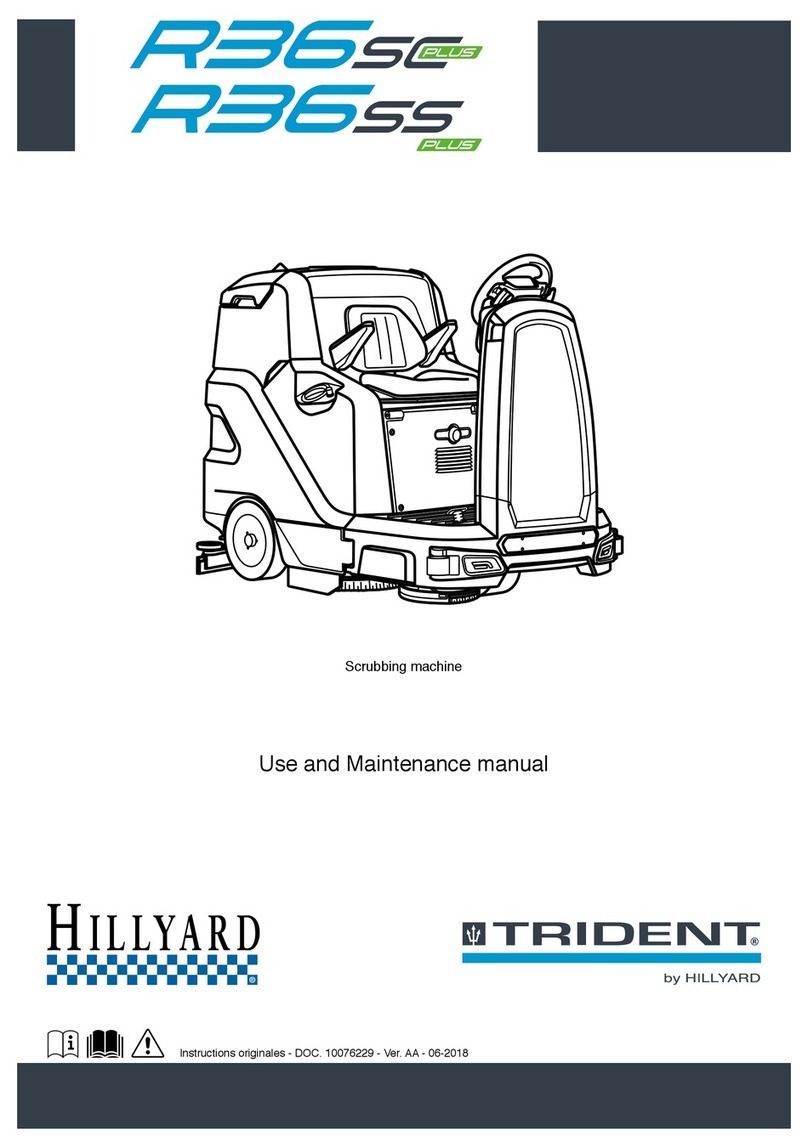
Hillyard
Hillyard TRIDENT R36 SC PLUS User manual

Hillyard
Hillyard TRIDENT R26SC PRO User manual

Hillyard
Hillyard TRIDENT NM14 User manual

Hillyard
Hillyard TRIDENT T30SC PRO User manual
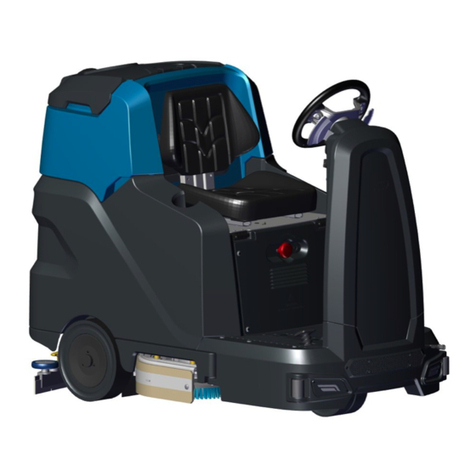
Hillyard
Hillyard TRIDENT R30SC User manual

Hillyard
Hillyard TRIDENT R30SC User manual

Hillyard
Hillyard TRIDENT B20SC User manual
Popular Scrubber manuals by other brands

Alto
Alto Bext 100 Operator's manual
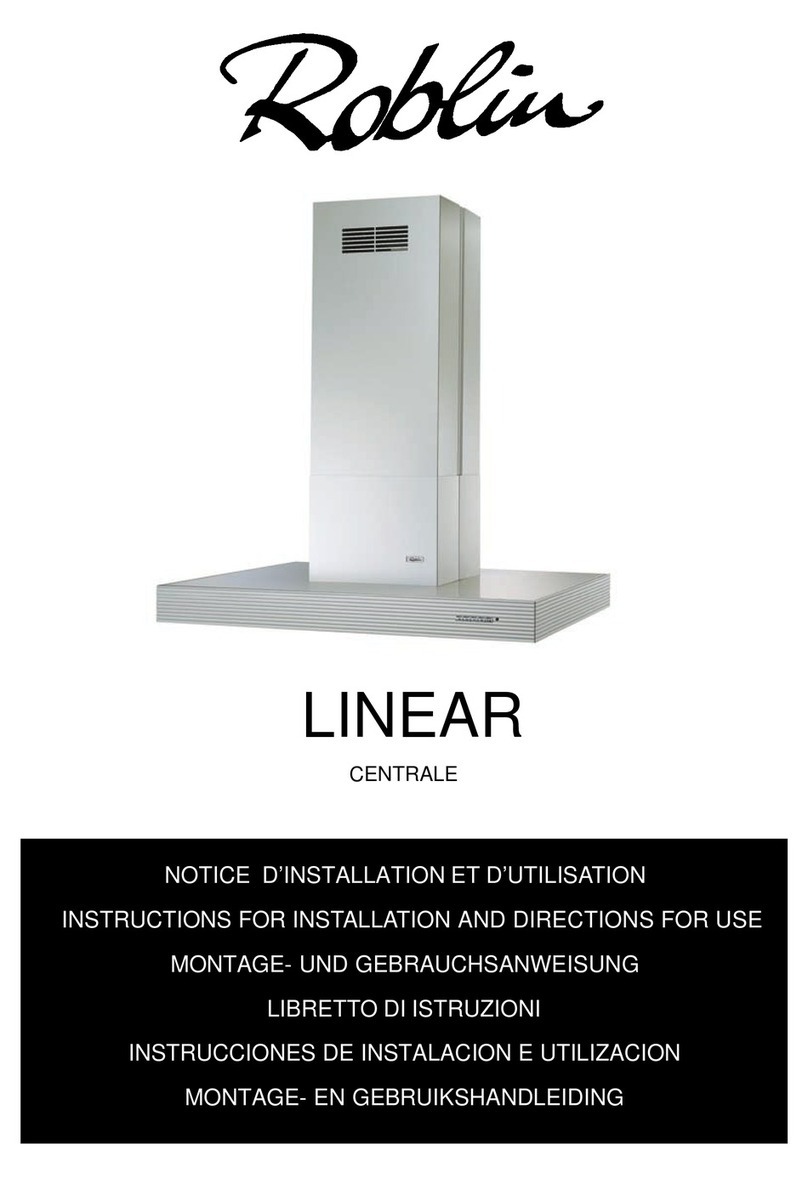
ROBLIN
ROBLIN LINEAR CENTRALE Instructions for installation

Windsor
Windsor SABER GLIDE 10053070 operating instructions

Windsor
Windsor Saber Compact QSC20 Operator instructions

Lamona
Lamona LAM2543 User's installation guide

Hydro-Force
Hydro-Force Nautilus MX200 operating manual
